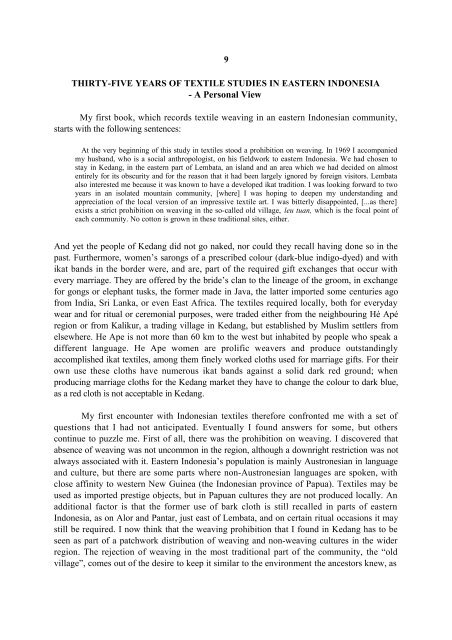download - OATG. Oxford Asian Textile Group
download - OATG. Oxford Asian Textile Group
download - OATG. Oxford Asian Textile Group
Create successful ePaper yourself
Turn your PDF publications into a flip-book with our unique Google optimized e-Paper software.
9<br />
THIRTY-FIVE YEARS OF TEXTILE STUDIES IN EASTERN INDONESIA<br />
- A Personal View<br />
My first book, which records textile weaving in an eastern Indonesian community,<br />
starts with the following sentences:<br />
At the very beginning of this study in textiles stood a prohibition on weaving. In 1969 I accompanied<br />
my husband, who is a social anthropologist, on his fieldwork to eastern Indonesia. We had chosen to<br />
stay in Kedang, in the eastern part of Lembata, an island and an area which we had decided on almost<br />
entirely for its obscurity and for the reason that it had been largely ignored by foreign visitors. Lembata<br />
also interested me because it was known to have a developed ikat tradition. I was looking forward to two<br />
years in an isolated mountain community, [where] I was hoping to deepen my understanding and<br />
appreciation of the local version of an impressive textile art. I was bitterly disappointed, [...as there]<br />
exists a strict prohibition on weaving in the so-called old village, leu tuan, which is the focal point of<br />
each community. No cotton is grown in these traditional sites, either.<br />
And yet the people of Kedang did not go naked, nor could they recall having done so in the<br />
past. Furthermore, women’s sarongs of a prescribed colour (dark-blue indigo-dyed) and with<br />
ikat bands in the border were, and are, part of the required gift exchanges that occur with<br />
every marriage. They are offered by the bride’s clan to the lineage of the groom, in exchange<br />
for gongs or elephant tusks, the former made in Java, the latter imported some centuries ago<br />
from India, Sri Lanka, or even East Africa. The textiles required locally, both for everyday<br />
wear and for ritual or ceremonial purposes, were traded either from the neighbouring Hé Apé<br />
region or from Kalikur, a trading village in Kedang, but established by Muslim settlers from<br />
elsewhere. He Ape is not more than 60 km to the west but inhabited by people who speak a<br />
different language. He Ape women are prolific weavers and produce outstandingly<br />
accomplished ikat textiles, among them finely worked cloths used for marriage gifts. For their<br />
own use these cloths have numerous ikat bands against a solid dark red ground; when<br />
producing marriage cloths for the Kedang market they have to change the colour to dark blue,<br />
as a red cloth is not acceptable in Kedang.<br />
My first encounter with Indonesian textiles therefore confronted me with a set of<br />
questions that I had not anticipated. Eventually I found answers for some, but others<br />
continue to puzzle me. First of all, there was the prohibition on weaving. I discovered that<br />
absence of weaving was not uncommon in the region, although a downright restriction was not<br />
always associated with it. Eastern Indonesia’s population is mainly Austronesian in language<br />
and culture, but there are some parts where non-Austronesian languages are spoken, with<br />
close affinity to western New Guinea (the Indonesian province of Papua). <strong>Textile</strong>s may be<br />
used as imported prestige objects, but in Papuan cultures they are not produced locally. An<br />
additional factor is that the former use of bark cloth is still recalled in parts of eastern<br />
Indonesia, as on Alor and Pantar, just east of Lembata, and on certain ritual occasions it may<br />
still be required. I now think that the weaving prohibition that I found in Kedang has to be<br />
seen as part of a patchwork distribution of weaving and non-weaving cultures in the wider<br />
region. The rejection of weaving in the most traditional part of the community, the “old<br />
village”, comes out of the desire to keep it similar to the environment the ancestors knew, as
















